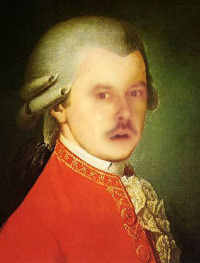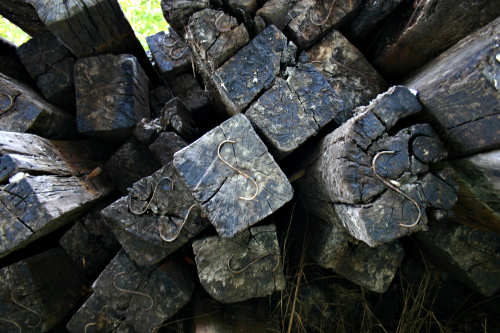A 365-Day Project
"We Are All Mozart"
A project to create
new works and change
the perception of the
music of our time.


 August 19, 2006
August 19, 2006 
It's time to talk about the nonpop revolution. Let's try that as a proper nominative: The NonPop Revolution, intercaps & all. Sounds good, looks good. So what is it?
The NonPop Revolution is a phrase that encapsulates the observation about a tectonic shudder in the musical earth, and a visible change in the surface landscape. In other words, both the music and the milieu have shifted. To put it simply, the experiment is over for the time being. What could be learned is learned, and the composers now coming into their own strength are children of postmodernism.
The older stylistic generation is hanging on, to be sure, but their significance as vital, moving artistic forces is fading. The musical politics of academic modernism, avant-garde confrontation, minimalist rejection, and even new complexity are settling into history just as serialism, neoclassicism, and futurism did before them. This is not judgment, but a mere fact of artistic process through time (though it is disturbing to one whose gums are receding). The older stylistic generation warred with itself so bitterly that it wrecked the public enthusiasm for an involvement in nonpop for the better part of a century, sweeping with it its heirs and revolutionaires so that the middle generation -- composers in their thirties and forties -- are still showing the tics and spasms of a self-questioning of artistic worth. (The "Chatter" sections of NewMusicBox frequently despair over the place of new nonpop in the culture -- although continuing to call it "classical music" or "new music" doesn't much help the cause.)
Geography and class continue to play a role in how advanced the NonPop Revolution is in the United States (the revolution's source) and the rest of the world. The U.S. took a long time to get its own legs under its compositional torso, having capitulated to European influence shortly after the Billings-era composers of the late 18th Century. It struggled to find its own voices for more than a century, with authentic sounds in jazz and the small number of originalist composers such as Cage, Antheil, Cowell, Partch, Copland, Thomson, and Feldman. One might point to minimalism as the final disconnection from Eurocentrism, though throughout the 20th Century the assimilative nature of the U.S. has expanded the compositional weave, threading in sound, technique, style and concept from Africa, Asia, the Near East, Australia and the South Pacific (and to a lesser degree, Central and South America).
This lateral geographical expansion is significant not so much for its incorporation of other styles, but for the malleability it introduces into American musical thinking -- a malleability that saw the overthrow of the sesquicentennial dominance of European composers from Hewitt and Selby through Dvorák and Weill to Stockhausen and Boulez. By the early 1980s, the reverse influence of American nonpop composers joined the extant influence of jazz composers emanating outward from the North American continent.
Once incorporation of alternative tunings and culture-specific instrumentation into mainstream nonpop (not used oxymoronically!) and film becomes normal, then the shift will work its way up to the symphonic class. The class structure of nonpop is highly problematic, because the upper class of the musical establishment is still rooted in the European model. All fields are subject to class stratification, but entertainment -- and symphonic nonpop and its kin are certainly more entertainment as a mirror of the status quo than art as a force of change -- is horizontally sliced with the uppermost layer insulated by a nearly impermeable barrier. Despite the barrier, however, the symphonic class (in which are included the major orchestras as well as entertainers like Yo-Yo Ma and Anne-Sophie Mutter, bonded to the peripheral tawdriness of André Rieu or Yanni, and borderline entertainment-art acts such as Polygraph Lounge and Ethel) rests upon the creative strata, a shifting base subject to unexpected liquefaction.
That liquefaction, the NonPop Revolution, is happening now. It can be heard in the American viewpoint (and "American" is used only for geography, not politics) -- not only the half century of assimilation of world music influences, especially from Asia rather than Europe (though that was already well underway, more visibly on the West Coast, but inside Japan, Indonesia, and waiting for a broader shift in China, on its way back to the North American continent) but also in the unembarrassed and expected incorporation of those influences -- that is unlike the past in its sylistic incongruity: postmodern, with more content and more quickly shifting content manifested by the fruits of a smaller, connected world vineyard. The diversity is sharply visible, whereas what Verdi and Wagner had in common was more than what separated them (in terms of instrumentation, Zeitgeist, dramatic shape and size, and the types of stories to be told).
The NonPop Revolution tells different stories. A few days ago I presented a list of composers that do not fit into the classical genre, and those composers and hundreds of others are liquefying the soil underneath the hardened symphonic class, which will shortly crack, with the liquid rushing up through the cracks to submerge or assimilate the upper layers. Whether it is a submersion or assimilation is unimportant; the significance is the inevitable and sudden change that will occur. The distinctive factors from the past century are found in the spread of stylistic differences and the sheer numbers of active nonpop composers who en masse represent forces of influence not before felt.
With reference to my earlier list, one can identify mystical symphonism, ritual vocalization, alternate-tuning power chords, contrapuntal pseudo-opera, altered voices in electronic transformation, interactive electronic soundscape, extended voices, environmental transformation, structured improvisation, high-drive chamber music, massed instrumental soundwalls, extended voice in electronic confrontation, electro-classical glitch, transformed song, magical spatial stagecraft, sound suspended in time, post-human instrumental performance, electro-geophysical sonic formations, unique instruments in noise collage, extended instrumental suspension, westernized monkey chant, hyperpersonal vocal extensions, microtonal fluidity of melodic weave, randomized sonic textures, rock-influenced political string improvisation, tube-filtered vocal soundshapes, classic rock-looping minimalism, virtuosic performance and narration, non-specific fugal sound texture, ululative multiple self-improvisation, coloristic instrumental sound walls, acoustic/electronic stage drama, mathematical romanticism, jazz symphonism, world-influenced electronic symphonism, resonant-tuned soundscape, electronically transformational chamber music, ancientized microtonal drama, electronic cantillation, extended spectral interweave, high minimal vocalization, body sound construction, electronically-joined symphonism, time-suspended baroque, minimal live instrumental looping, computerized sound mysticism, electrovocal hymnody, transformational classicism, pure electronic patterning, percussive improvisation, sonic hypnotism, electronic dreamscaping, acoustic density drama, chamber opera, rhythmic postclassic chamber drive, computerized sound-drama, stochastic soundworld introversion, and in-your-face post-avant-garde scat.
If you were following along with your index finger, you know how much of the above is description contrived by a hyperactive imagination following sambal in sizzling dol sat bowls. On the other hand, you also know that none of those descriptions, however initially fanciful, could be applied to music from the previous history of classical/nonpop. This level of distinction in this quantity simply cannot exist without undermining the calm, stable soil of the classical crust. It's true that Europe continues on its own (and older) path into a future wilderness and parts of Asia still maintain a high fascination with the traditional Western classical model. Nonetheless, the breadth and depth of change are what matters, and the sheer mass of imaginative new nonpop being carried across and out of the U.S. and allied cultures into the world at large is staggering.
There are nevertheless extant questions. One of them is the "big idea" on which I commented two years ago in ArtsJournal, which has still produced only a subculture of diminishing 'classical' meaning. About this diminishment I wrote, "The cultural catastrophe for Big Ideas is evident: We cannot find any because there is no context within which they can be Big. Critics write lukewarm praise or dismissal, audiences ... have been trained to quash their reactions, and fiscal circumstances have relegated the enthusiasm-engendering pieces to be played out of town or at the academy or in the countryside -- where they are guaranteed to be forgotten. And, in the end, there is no risk (particulary an economic one) which demands return on investment."
The "big idea" problem rests beyond geography, within the diversity of style and technique. Who can resolve for an audience, for example, the staggeringly difficult and beautiful Bach cello suites with the staggeringly difficult and beautiful multiple-bow compositions of Frances-Marie Uitti? How can the symphonic class resolve the chamber music of Mozart or even the Bartók quartets played by Takács with the progressively more adventurous chamber ensembles beginning with Kronos and moving to the Absolute Ensemble and Alarm Will Sound through Anti-Social Music?
Beyond music with obvious classical forebears, so much movement has occurred under the surface from electronic music (the classic definition), performance work, noise arts and even the whole panoply of nonpop-joining-to-pop in electronic music (the postmodern definition) that the symphonic class is barely holding on -- to its audiences, to its repertoire, to its budgets. The reason for the collapse of the large orchestras has nothing to do with superficial concerns for audience or entertainment that are repeated in the classical media, but rather with a fundamental level of dissatisfaction combined with fundamental substrata of change that have not taken clear form in their symbiotic effects.
Indeed, the results of revolutions are never clear at the outset or even well into the unfolding of events, and the NonPop Revolution is no exception. Wagner, Schoenberg, and Stockhausen all had revolutions on their lips, and all failed -- but their times were historically coherent in musical terms, even Schoenberg's and Stockhausen's, despite the political madness that preceded their respective breakthroughs. (If there's an analogy -- help me, historians -- it is to the Ars Nova. Another day for that.) New nonpop is solid, imaginative, experimental, professional; in other words, with all the characteristics of the living arts in which the symphonic classes once participated. The nonpop shift is broad and media-infused, and worldwide -- and may, just may, be forced for a while to abandon its treasured symphonic class to the province of bread and circuses. For a while. Until the crust cracks.

It's my habit to walk along the railroad tracks that run past the house. I have always loved trains, and enjoy photographing their strange habitat. Here are some railroad ties removed from service.